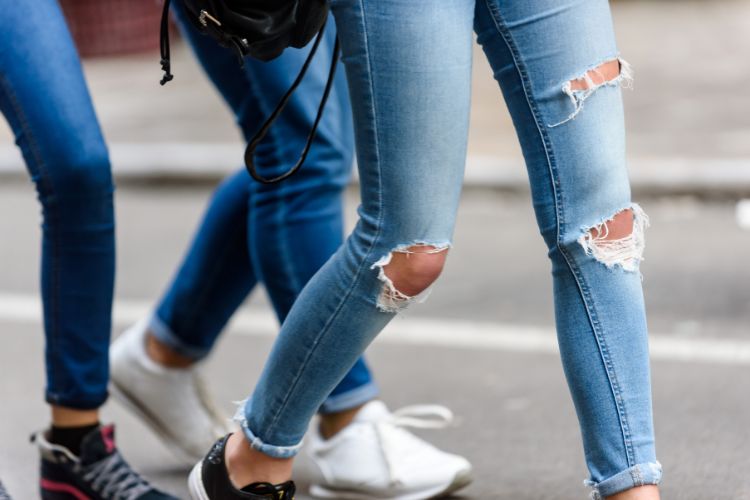School dress codes have been a perennial subject of debate, and one item of clothing that often finds itself at the center of this controversy is ripped jeans.
For many students, wearing ripped jeans is a fashion statement, but in countless schools across the United States, they are strictly prohibited.
Have you ever wondered why schools don’t allow ripped jeans? In this article, we’ll explore the underlying reasons behind this prohibition.
Quick Navigation
Reason 1: Maintaining a Professional Atmosphere
One of the primary reasons why schools discourage or outright ban ripped jeans is to maintain a professional atmosphere within the learning environment.
Schools are not just places of education; they are a microcosm of the world where students are exposed to various situations and interactions.
Dressing appropriately for school is considered a way of preparing students for their future careers.
Ripped jeans, with their casual and often disheveled appearance, may not align with the goal of cultivating professionalism.

Many schools believe that by imposing dress code restrictions, they can help students understand the significance of dressing appropriately for various situations.
In fact, in some schools, jeans are banned, and even teachers are prohibited from wearing them to set a good example for their students.
This approach aims to impart a valuable life lesson since students will eventually need to navigate workplaces with their own dress codes. It’s crucial to prepare their mindset during their school years.
Reason 2: Distraction Prevention
Another important reason behind the ban on ripped jeans is to minimize distractions in the classroom.
Education is most effective when students can focus on their lessons without unnecessary interruptions. Ripped jeans, especially those with excessive tears and frays, can draw undue attention.

Other students might find themselves distracted by the tears in their classmates’ clothing, which can hinder the learning process for everyone involved.
Teachers also benefit from a dress code that discourages ripped jeans, as it allows them to maintain a productive and focused classroom environment. Minimizing distractions helps ensure that students get the most out of their education.
Reason 3: Safety Concerns
Student safety is paramount in any educational institution.
Ripped jeans, depending on the size and location of the rips, can raise legitimate safety concerns.
Exposed skin may be vulnerable to scratches, scrapes, or even minor accidents. This is especially relevant in settings where hands-on activities are common, such as science labs or physical education classes.

To mitigate potential risks and ensure the well-being of students, many schools opt to ban ripped jeans as a precautionary measure. The intent is not to stifle fashion choices but to prioritize safety.
Reason 4: Uniformity and Equality
Some schools adopt dress codes or uniform policies to create a sense of unity and equality among students.
By enforcing a standard dress code that disallows ripped jeans, schools ensure that students dress in a similar, non-disruptive manner.

This practice can help reduce socio-economic disparities and minimize the pressure on students to conform to expensive fashion trends.
A standardized dress code can also help prevent issues related to clothing-based discrimination, such as bullying or exclusion based on attire choices.
By promoting a sense of belonging and equality through dress code policies, schools aim to foster a more inclusive and harmonious school environment.
Ripped Jeans and Dress Code Considerations
The question of whether banning ripped jeans in schools is appropriate remains a subject of ongoing debate.
Supporters argue that such bans are necessary to maintain a professional and focused learning environment, minimize distractions, and prioritize safety.
Meanwhile, critics assert that they infringe on students’ freedom of expression and may be based on outdated standards.

Finding the right balance between enforcing dress codes and respecting students’ individuality is a challenge that many school communities grapple with.
Here are some practical solutions that can balance individual expression with the need for a conducive learning environment.
1. Clear Guidelines: Schools can benefit from establishing clear and specific guidelines on the extent of permissible “ripped” jeans, providing students with a defined framework for their attire.
2. Educational Initiatives: Initiatives focused on educating students about dressing appropriately for different contexts can empower them to make responsible clothing choices and understand the importance of adhering to dress code policies.
3. Parent and Student Involvement: Involving parents and students in discussions and decisions regarding dress code policies fosters a sense of shared responsibility and helps ensure that policies align with community values.

4. Regular Reviews: Periodic reviews and updates of dress code policies are essential to keep pace with evolving fashion trends and changing expectations, maintaining their relevance and fairness.
5. Enforcement with Sensitivity: Dress code enforcement should emphasize education over punishment, encouraging students to make informed choices regarding their attire.
6. Optional Dress Days: To strike a balance between personal expression and professionalism, schools may consider designated “casual” or “dress-down” days when students can wear relaxed attire, including ripped jeans, while maintaining a respectful and focused learning environment.

Conclusion
The choice to restrict ripped jeans in schools isn’t a random or arbitrary one; it’s based on several good reasons.
Schools want to make a place where everyone can focus on learning, act professionally, and stay safe. Their goals and standards are set to benefit all students.
Dress codes in schools serve as a valuable preparation for students, teaching them the expectations they will encounter in their future careers.
However, schools can consider more flexible rules that permit personal expression. By doing so, they show their commitment to accommodating student needs and values, fostering an environment where individuality and responsibility coexist harmoniously.
Hi, I’m Grace Alision, a fashion lover with a passion for helping women feel confident and beautiful through their style choices. I created this website to share my love for wedding guest dresses and, in the future, to explore concert outfit inspiration. Dresses have always been my favorite way to express elegance and individuality, and I’m here to make finding the perfect outfit fun and easy. When I’m not working on outfit ideas, I love discovering new trends and connecting with others who share my love for fashion.

